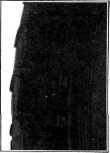1942 - 1947 CHEVROLET SHOP MANUAL
Section 10 - Wheels & Tires
|
|
||||
|
10-1
|
||||
|
|
||||
|
Section 10
WHEELS AND TIRES
|
||||
|
|
||||
|
INFLATION PRESSURES
Maintaining the correct inflation pressures is
one of the most important elements
of tire care. The
inflation pressure recommended for any model
car or truck is carefully worked
out as the best pressure
to give an efficient balance of the following
factors of good car performance: comfortable
ride, stability, steering ease,
even tread wear, tire cord
life and immunity from blowouts.
It is recommended that tires in ordinary use be
checked for proper pressure once
each week. This will result
in added tire life as 2 pounds pressure
will normally be lost in a week of
ordinary driving. Cars
operated at high speeds or in more than
ordinarily severe service should
have the tires checked at
more frequent intervals.
Inflation pressures are extremely important in
truck tires. The tires should
always be inflated so that
the full width of the tire tread is in firm contact
with the road and that a normal amount of
bulge shows on the sidewall of the
tire at the bottom. It is extremely detrimental to have the side-walls
of the tire bulge too much and it is also detrimental
to tire life to have the sidewall bulge too
little. The correct bulge for any
tire is obtained by loading
the tire to the maximum rated load and inflating it with the
corresponding inflation pressure
shown.
Truck tires are
expensive and will deliver many
more dollars worth of miles if they are properly
inflated and proper car taken of
all cuts and bruises.
TESTING FOR TIRE NOISE
The determination of whether tires are causing the noise complained of
is relatively simple. The car
should be driven at various speeds and note
taken of the effect of part
throttle, sudden acceleration,
and deceleration on the noise condition, as
axle and exhaust noises show
definite variations under
these conditions, while tire noise will remain
constant. Tire noise, is,
however, most pronounced at speeds of approximately twenty or
thirty miles per hour.
The tire noise may be further checked by driving
the car over smooth pavements or dirt roads
(not gravel) with the tires at
normal pressure and again
over the same stretch of road when the tires have been inflated to
fifty pounds pressure. If the
noise for which the test is being
made is caused by
|
tires, it will
noticeably decrease when the tire pressure is increased, whereas,
rear axle noise should show no change in volume as a result of changes
in tire pressure.
If, on inspection,
the tires on the front wheels are found to be creating most of the
noise, the alignment of the front wheels should be checked, as
excessive tire noise usually results from low tire pressure, incorrect
alignment or from uneven tire wear.
CORRECTION OF
IRREGULAR TIRE WEAR
Since irregular tire
wear is due to some action which causes certain places on a tire to
wear more rapidly than others, the remedy is naturally to correct the
condition causing the wear. However, after the adjustments have been
made, it is wise to interchange the tires to equalize the future
normal wear which will occur.
Tires may be
alternated several ways to even up irregular wear. However, the
following method is the simplest and, in most cases, the most
satisfactory.
Wheels should be
changed without dismounting the tires, right front to spare, spare to
right rear, right rear to left front, left front to left rear and the
left rear to right front.
HEEL AND TOE WEAR
Heel and toe wear is a
saw-tooth effect with one end of each tread block worn more than the
other.
The end which wears is
|
|||
 |
that which first grips the road
when the brakes are applied.
High speed driving and
excessive use of the
brakes will cause this type
irregular tire wear, on
any type tread design.
Heel and toe wear is not so
general on the rear tires
because of the propelling
action creating a counteracting
force which
|
|||
|
|
||||
|
Fig. 1-Heel and Toe Tire Wear
|
wears the opposite end
|
|||
|
of the tread blocks. These two
stresses on the rear tires cause the
tread blocks to wear in opposite
directions and
|
||||
|
|
||||